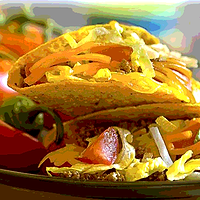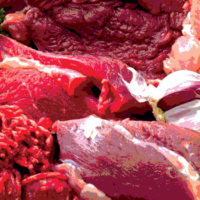Foodborne disease currently poses a significant global public health burden. In the U.S. alone, approximately 48 million people get sick, 128,000 are hospitalized and 3,000 die from foodborne diseases on a yearly basis. Recent evidence suggests contaminated fresh produce is often the cause of such foodborne disease. Between 1990 and 2005, 13 percent of all reported foodborne outbreaks and 21 percent of reported illnesses were attributed to contaminated fresh produce.[1,2] Such effects are not limited to the U.S. The European Food Safety Authority (EFSA) reports that from 2007 to 2011, 10 percent of pathogenic outbreaks, 26 percent of the cases, 35 percent of the hospitalizations and 46 percent of the deaths were associated with foods of nonanimal origin, including fresh produce.[3]
Along with public health impacts come significant economic consequences. According to a recent report from the U.S. Department of Agriculture’s Economic Research Service, foodborne illnesses cost the U.S. economy more than $15.6 billion in 2014. This figure accounts for costs associated with inpatient medical care, outpatient expenses, estimates of healthcare costs required to improve a patient’s medical condition, lost wages and costs associated with continued evaluation of foodborne infections. For example, treatment costs for the common foodborne pathogen Salmonella totaled $3.6 billion, and costs for Listeria monocytogenes and Escherichia coli totaled $2.6 billion and $271 million, respectively.[4]
Contamination of fresh produce can occur at several stages across the production chain, including harvesting from the field or orchard, transporting, processing, distribution or marketing at the grocery store. Further opportunities for contamination arise during food preparation in foodservice establishments or in the home (i.e., “farm to fork”). Possible contamination sources range from irrigation water, animals, insects, soil and manure, to infected food handlers or improperly sanitized food contact surfaces.
How to Handle the Problem?
Currently, fresh produce and food preparation surfaces are typically disinfected with chlorine (in elemental form or as a hypochlorite) or chlorine dioxide. While chlorine is permitted for use as a disinfectant on organic produce, the U.S. Environmental Protection Agency set a limit of residual chlorine equal to the drinking water limit of 4 mg/L. Achieving such low residual levels requires dilute chlorine solutions that are not nearly as effective at properly sanitizing food or food contact surfaces. Other commonly used disinfectants include peracetic acid, hydrogen peroxide, quaternary ammonium compounds or ozone (in either gaseous or liquid form). However, these chemical intervention methods (including chlorine) can leave behind residues that ruin the food’s taste or pose a skin-irritation hazard for food handlers. Other food suppliers may use ultraviolet radiation. However, this method can slow down ripening and induce visible damage on the produce if improperly applied. Furthermore, most of these methods lack the versatility to be used across the food’s production and distribution cycle. Such interventions are often only used at Critical Control Points, such as postharvest or during food packaging, leaving many opportunities for cross-contamination across fresh produce stocks. Despite these limitations, there is currently a great need for effective and versatile antimicrobial interventions that can be applied from farm to fork.
Thinking “Small” for Big Solutions
Recent advances in nanotechnology may provide a unique alternative intervention method to address the problem of foodborne diseases. For the past decade, researchers and the media have been hyping “nano,” or substances smaller than 100 nanometers (billionths of a meter) in one dimension, as a transformative technology with applications across a wide variety of sectors. Recent advancements have improved researchers’ and industry’s ability to engineer and characterize these extremely small particles, and nanotechnology has become a major economic force in the 21st century.
The promise of nanotechnology is predicated on the fact that nanoscale materials often exhibit properties distinct from their micron-size counterparts. For example, nanoscale iron oxide loses its magnetism, and nanogold turns red in color. For the purposes of eliminating foodborne pathogens, many nanoparticles exhibit antimicrobial properties. Photocatalytic nanoparticles made of zinc oxide and titanium oxide help degrade harmful volatile organic compounds and kill microorganisms when incorporated into food packaging materials, thereby keeping food fresher and extending shelf life. Similarly, silver nanoparticles are used in food packaging for their antimicrobial properties. Studies suggest that nanoscale silver particles are capable of killing 650 disease-causing pathogens in food and may also be less susceptible than traditional antimicrobials to the development of bacterial resistance. Nanosilver is also readily incorporated into various materials and matrices, such as textiles and plastics. Several food storage and food contact products currently available on the market already contain nanosilver and claim benefits including extended shelf lives for fruits, vegetables, breads, meats and other food items.
However, such approaches may not be applicable across the entire production and distribution cycle, and concerns remain regarding potential hazards to human health and the environment. The mechanisms that allow nanoparticles to kill bacteria may also pose a risk to the very people they are intended to protect. Due to their small size, nanoparticles may penetrate biological barriers and trigger severe adverse health effects. For instance, inhaled nanoparticles have the capacity to evade typical clearance mechanisms, translocate across the alveolar epithelium of the lung and migrate to other sensitive organs including the kidneys, liver and brain. Similar concerns over ingested nanoparticles are not well understood and are currently a hot topic for toxicological research. For industry and researchers, the question remains how to help nanotechnology reach its full potential while still preserving public safety.
Safe-by-Design Nano Water Droplets
Safe-by-design nanotechnology requires engineering advanced materials and technologies that maintain desirable functionality and antimicrobial properties while also reducing hazards and risks to human health and the environment. Researchers at the Harvard T.H. Chan School of Public Health are currently investigating possible “safe-by-design” approaches to food safety. Associate professor of aerosol physics and director of the Center for Nanotechnology and Nanotoxicology Philip Demokritou and his research team are working with “engineered water nanostructures” (EWNSs). Demokritou and his group propose these nanosize water droplets may offer a safe, cost-effective way to kill foodborne pathogens.
EWNSs are generated by harnessing water vapor present in ambient air using a process called electrospraying. The electrospray system consists of a gold-plated electrode that is chilled by a cooling element to condense water from the atmosphere on its microsize tip, and a second concentric electrode hovering 5 millimeters below. When activated with high voltage, the condensed water is electrically charged and drawn toward the circular electrode. Surface tension, however, grips the water droplets to the gold-plated electrode until the strain becomes too much. Under this immense strain, the condensed water drop eventually explodes into a spray of droplets, each just 25 nanometers in size, which is 2,000 times smaller than the width of a human hair.
In addition to their small size, EWNSs possess unique properties with implications for food safety. Georgios Pyrgiotakis, a postdoctoral fellow in Demokritou’s group and lead author on several recent publications on this new technology, reports that EWNSs contain massive payloads of reactive oxygen species (ROS). ROSs are known to attack cellular membranes, damage DNA, oxidize enzymes and degrade other proteins necessary for cellular or microbial survival. If a droplet happens to bounce into a microbial pathogen, EWNSs act like “nanobombs,” releasing ROSs that can do serious damage and effectively kill the pathogen. Pyrgiotakis also determined that the tiny water particles persisted in the air for hours instead of evaporating immediately as expected. Droplets this small would usually evaporate in a fraction of a second. However, because the condensed water is so pure, there are almost no other molecules with which they can react. Furthermore, optimizing the voltage applied to the needle in the electrospray system ensures the particles develop a strong enough surface charge (on average 10–40 electrons/particle) to significantly increase surface tension and reduce evaporation. These highly charged nanobombs can persist in the air for hours, increasing the likelihood they come into contact with unwanted microbes.
Effective Bug Killer
In a study published in Environmental Science & Technology, Pyrgiotakis investigated just how effective these EWNSs were at killing representative foodborne pathogens.[5] To test this, researchers inoculated stainless steel food production surfaces with representative foodborne bacteria E. coli, Salmonella enterica and Listeria innocua. EWNSs were generated at an average aerosol concentration of 24,000 particles/cm3 and delivered to the bacteria-infected surfaces via diffusion for a 90-minute exposure period. On the stainless steel surfaces, they observed 0.6- to 1.8-log reductions in bacterial counts, depending on bacterial type.
The EWNS system was then optimized to produce higher concentrations of particles that were targeted to deposit directly on the surface of inoculated organic grape tomatoes.[6] In this optimized system, average aerosol concentrations were achieved ranging up to 40,000 particles/cm3. Particles were directed toward contaminated tomatoes with an electrostatic precipitator exposure system. After a 45-minute exposure period with the optimized system, researchers saw 2.2-, 3.8- and 3.8-log reductions for S. enterica, L. innocua and E. coli, respectively. For comparison, typical chemical treatments such as chlorine or peroxyacetic acid washes can achieve 1- to 3-log inactivations of E. coli O157:H7, Listeria and Salmonella spp. within 3 minutes.[7] These results with the optimized EWNS system suggest a promising future for the use of highly charged, nano-size water droplets as an alternative method for disinfecting food and food contact surfaces.
A Cleaner, Safer Alternative
In addition to effectively killing microbial pathogens, this novel, chemical-free and environmentally friendly intervention holds great potential as a “green” alternative to inactivation methods currently used in the food industry. Using an optimized electrospray system, nano-size droplets are formed from water vapor already present in the air. There are no residues to worry about, and after a few hours, everything evaporates back into water vapor.
To address concerns of potential human health effects associated with breathing in large quantities of the EWNSs, Demokritou’s group used an animal model to investigate lung toxicity following inhalation exposure. Mice were exposed to EWNSs for 4 hours at levels 50 percent higher than the concentration used for attacking microbial pathogens (60,000 particles/cm3). The mice exhibited no respiratory tract toxicity, no increase in lung inflammatory markers, no increase in cell death and no changes in breathing patterns.[8] In fact, they appeared completely unaware of the EWNSs they were breathing. The researchers hypothesized the alveolar lining fluid in the mouse lungs neutralized the nanobombs before they could come into contact with living cells, although more research may be necessary to confirm this.
In light of these results, Demokritou believes electrospraying could be used as a cost-effective approach that can be easily deployed at various intervention points. EWNSs could be applied to produce from farm to fork, including postharvest, on a transport truck or even as an invisible mist in the grocery aisle. Research indicates EWNSs are capable of reducing common foodborne pathogens like E. coli, Salmonella and Listeria, as well as yeasts and fungi that cause food to spoil. Such a versatile technology could help significantly decrease the microbial load on fresh produce and extend shelf life, as well as reduce the number of cases of foodborne illnesses from consumption.
Joel M. Cohen, Sci.D., is a toxicologist with Gradient Corporation, an environmental and risk sciences consulting firm.
References
1. Abadias, M et al. 2008. “Microbiological Quality of Fresh, Minimally Processed Fruit and Vegetables, and Sprouts from Retail Establishments.” Int J Food Microbiol 123:121−129.
2. www.cspinet.org/foodsafety/IAFPPoster.pdf.
3. Panel on Biological Hazards. 2013. EFSA – Scientific Opinion of the BIOHAZ Panel: “Risk Posed by Pathogens in Food of Non-Animal Origin: Part 1.” Eur Food Saf Author J 11:1−138.
4. www.ers.usda.gov/data-products/cost-estimates-of-foodborne-illnesses.aspx#48446.
5. Pyrgiotakis, G et al. 2015. “Inactivation of Foodborne Microorganisms Using Engineered Water Nanostructures (EWNS).” Environ Sci Technol 49:3737−3745.
6. Pyrgiotakis, G et al. 2016. “Optimization of a Nanotechnology-Based Antimicrobial Platform for Food Safety Applications Using Engineered Water Nanostructures (EWNS).” Sci Reports doi:10.1038/srep21073.
7. Neo, SY et al. 2013. “Efficacy of Chlorine and Peroxyacetic Acid on Reduction of Natural Microflora, Escherichia coli O157:H7, Listeria monocytogenes and Salmonella spp. on Mung Bean Sprouts.” Food Microbiol 36:475–480.
8. Pyrgiotakis, G et al. 2014. “A Chemical-Free, Nanotechnology-Based Method for Airborne Bacterial Inactivation Using Engineered Water Nanostructures.” Environ Sci Nano 1:15−26
“Nanobombs” Protect Consumers from Foodborne Microorganisms




